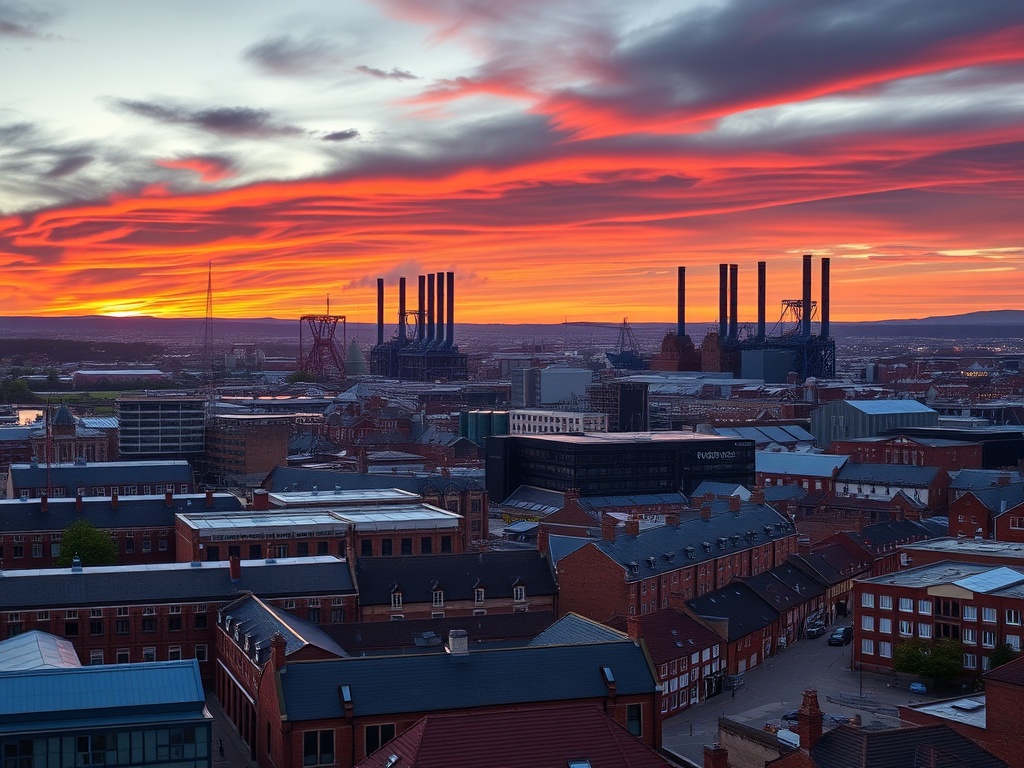The Resurgence of Barrow-in-Furness: From Decline to Opportunity

As the only builder of nuclear submarines in the UK, Barrow-in-Furness in Cumbria stands in a unique position to emerge as a significant engineering and manufacturing hub in post-industrial Britain. “We have a second chance,” states Frank Cassidy, a Labour councillor representing a central ward in Barrow, while gazing at the vast Devonshire Dock Hall, where submarines are currently being constructed. “There is an undeniable buzz in the air,” he continues. “Which other town in the UK can boast guaranteed, high-quality jobs for an entire generation?”
However, the town faces a pressing labour shortage, as noted by Jayne Moorby, a market manager and community advocate. She explains that BAE Systems, the company responsible for submarine construction, “offers such competitive salaries that it hampers other sectors of society, making it difficult to find car mechanics, teachers, healthcare workers, taxi drivers, and many others.”
Barrow is, in many ways, a quintessential company town, heavily influenced by BAE Systems, the UK’s largest defence contractor. Janet Garner, the future workforce director at BAE, reveals that the company currently employs 14,500 staff in Barrow, ranging from nuclear engineers to cleaning personnel, with projections indicating an increase to nearly 17,000 employees within the next decade or so. The majority of these workers reside in or near Barrow, which, with a population of 67,400, lacks many other major employers aside from the local hospital and the council.
Not long ago, Barrow was experiencing the same gradual decline as many other de-industrialised towns that thrived during the Victorian era. Situated at the end of a blunt peninsula that juts into the Irish Sea, south of the scenic Lake District, Barrow once flourished following the discovery of high-quality iron ore in the mid-19th century. It became home to the world’s largest iron and steel plant, while its shipyards were responsible for constructing the Royal Navy’s first submarine, HMS Holland, in 1902, and even sold a battleship, the Mikasa, to the Japanese navy, which played a significant role in the Russo-Japanese War. During World War II, Barrow was targeted by the Luftwaffe due to its crucial involvement in British submarine and surface vessel production. However, as the UK underwent de-industrialisation, the ironworks shut down in 1963, followed by the steelworks in 1983.
With the conclusion of the Cold War in the 1990s, defence budget cuts led to a significant decrease in new orders. “By the early 2000s, we were down to fewer than 3,000 workers,” recounts Garner, referring to a time in Barrow that resulted in “a missing generation who had no access to decent employment.” Unlike many industrial towns across the UK, Barrow’s downturn was short-lived, thanks to its specialization in nuclear submarine production, a key component of the UK’s nuclear deterrent strategy. The shipyard is currently finalizing the seventh and final Astute-class attack submarine for the Royal Navy, while the Dreadnought submarines are set to replace Trident, with the nuclear missiles being supplied by the US. Additionally, the shipyard is engaged in building nuclear submarines for Australia as part of the AUKUS pact, established in 2021 between Australia, the US, and the UK.
While Barrow is unique in the UK for its nuclear submarine manufacturing capabilities, the town’s experiences may offer insights for other regions as tensions with Russia escalate. UK defence spending is on the verge of a significant increase, potentially leading to the expansion of arms factories across various towns and cities, benefiting local economies.
Sir Keir Starmer and the current government have openly acknowledged their vision of heightened defence procurement as a catalyst for economic growth. This approach not only allows them to bypass self-imposed borrowing limitations but also frames increased spending as a patriotic obligation.
While this is promising news for Barrow, the sudden transition from decline to growth has resulted in a paradoxical situation where the town grapples with the simultaneous repercussions of industrialization, de-industrialization, and re-industrialization. Although one can easily romanticize the past, life in Barrow before its industrial decline was often fraught with hardship. Chris Blackhurst, a journalist and former editor of The Independent, who spent his formative years in the town, recalls, “My father, a teacher who worked in the shipyard for additional income, succumbed to an illness related to asbestos exposure. People would board buses with their overalls still covered in asbestos or engage in snowball fights using the substance.” Respiratory illnesses caused by industrial pollution were so widespread that Barrow experienced significantly higher infection and death rates during the Covid-19 pandemic compared to the rest of England.
Anyone visiting or residing in Barrow can’t help but notice the stark contrast between the state-of-the-art shipyard and the aging, century-old terraced homes. Despite Cassidy’s optimistic outlook for Barrow’s future, he acknowledges that “just a few streets away from where nuclear submarines are being constructed, we still witness some of the worst deprivation in Britain.” He gestures towards the submarine manufacturing facilities that resemble enormous white aircraft hangars, juxtaposed with nearby multi-occupied brick tenements reminiscent of those found in Glasgow. According to the local Poverty Truth Network, one in five residents in Barrow lives in poverty. A similar proportion reports struggling to provide adequate food for themselves and their families, while an astonishing 42% of the housing stock predates 1918.
One of the few instances that garnered extensive national media coverage occurred in 2017-18, when 12 individuals tragically died due to Class A drug overdoses. Though the stigma remains, current statistics indicate that drug offences in Barrow are below the national average. Nonetheless, an article in The Sun last month labeled Barrow as “Smack City: the heroin-scarred seaside ‘brown town’.”
Much of the town’s deprivation is concentrated in four central wards, where many residents do not benefit from the high-paying jobs available at the shipyard. In the Barrow Central ward, a staggering 35.6% of children live in poverty. Mental health issues are prevalent, with Sam Plum, the CEO of Westmorland and Furness Council, noting that it is hardly surprising that individuals experience stress “when they struggle to feed their daughter several days a week.”
Michelle Scrogham, the newly elected Labour MP for Barrow and Furness in 2024, expresses the urgency of needing to convince those in power that the shipyard’s success obscures the struggles faced by many residents. For these individuals, “the impact of austerity has been devastating, stripping away vital safety nets.” As a result, the demand for healthcare in an industrial town like Barrow is “greater than in more affluent suburban areas.” She believes that those accountable for austerity policies “should feel deep shame for the harm caused to our communities.”
Numerous voices, both within and outside the town, point to the widening chasm between the “booming” and “left-behind” segments of Barrow. “We have some excellent teachers,” notes Andy Beeforth of the Cumbria Community Foundation, “but in certain schools, their primary focus is ensuring that children have food, clothing, and even basic toilet training.” He mentions that some children arrive at school with a vocabulary of fewer than 500 words. A former headmistress of a primary school, Caroline Vernon, emphasizes that “education is not a priority for those living in extreme poverty.” Their focus, she explains, is simply “survival: securing enough food becomes a genuine concern.”
However, many media portrayals of life in Barrow tend to overemphasize the negative aspects, often presenting a caricature of a grim, derelict northern town. “While it may appear to be a place in decline, the reality is that it is flourishing,” asserts Plum. “The shipyard’s order book is full for the next 30 years, and BAE Systems is looking to expand its workforce. If you were born in Barrow today, you would know that there are job opportunities awaiting you in 18 years’ time.” The town’s population is anticipated to grow by 10,000 over the next 10 to 15 years.
Despite the optimism surrounding Barrow’s economic prospects, attracting highly skilled individuals to the town is challenged by its undeserved reputation as an undesirable place to live. In 2014, it was identified by the Office for National Statistics as “the unhappiest place” in the UK, a label that received significant media attention and reinforced the southern English stereotype of a northern town, reminiscent of LS Lowry’s paintings depicting downtrodden figures trudging through industrial landscapes.
In reality, one can easily catch glimpses of the beautiful Lake District’s snow-capped mountains on the horizon above Barrow’s rooftops, just an hour’s drive away. However, when I reached out to a friend who has lived in the Lake District for many years, asking if he knew anyone in Barrow, he sounded puzzled by my request, as though I had asked for a contact in the Outer Hebrides. He politely explained that he had never visited Barrow and did not know anyone from there. During a train change at Lancaster, a helpful member of the station staff asked where I was headed, and when I mentioned “Barrow,” she replied, “Why on earth would you want to go there?”
Yet, Barrow possesses many attractive qualities. Its residents have a strong sense of community. “I have never encountered a place with such deep social bonds,” remarks Simon Fell, Barrow’s former Conservative MP. While the town centre may not be visually appealing due to many aging 19th-century terraced homes, it is surrounded by water on three sides and boasts beautiful architecture, including an impressive town hall. On Walney Island, the long, empty beaches stretch infinitely, and the ruins of Furness Abbey nestled in a small wooded valley are not far from the town, although they appeared closed to the public during winter.
What accounts for the reluctance of individuals from outside Barrow to make it their home, despite its burgeoning economy? Locals often attribute this to their geographical isolation at the end of a peninsula, accessible only via road and rail. However, Manchester is merely two hours away, with Lancaster and Preston about an hour’s journey to the south.
Residents lament that many individuals earning substantial wages at the shipyard choose to rent rooms in multi-occupied houses from Monday to Thursday before heading home for the weekend. However, the reality is that there is limited entertainment available in Barrow should they choose to stay. “Back in the 90s, there was a vibrant scene in the high street,” reflects Jayne Moorby. “But now, many shops have closed, and there is little for the youth to do at night.” Portland Walk, a pedestrianized thoroughfare at the town’s heart, appears desolate during the day, with boarded-up shops and scant customers in those still open. In an effort to revitalize the area, BAE Systems is converting the shuttered Debenhams into a training facility, hoping that well-paid apprentices will generate foot traffic for local coffee shops and retailers.
While this approach may hold promise, cities and towns nationwide are grappling with the challenge of revitalizing their high streets, often with limited success in the face of competition from sprawling out-of-town shopping centres offering ample free parking and the convenience of online shopping from home.
Barrow’s lack of diversity—only 3.8% of the population was born outside the UK—helps explain the scarcity of ethnic dining options compared to other areas. Despite this lack of ethnic representation, Barrow briefly became a focal point for racial tensions when a local girl, Ellie Williams, made a series of false allegations about being raped and assaulted by Asian men. Her claims sparked protests in Barrow, but a police investigation later revealed the truth, leading to her conviction and an eight-and-a-half-year prison sentence in 2022. “The incident nearly fractured the community,” recalls Fell, who was the MP for Barrow at the time.
Barrow presents a unique opportunity to assess how targeted investment can enhance and distribute the benefits of existing economic success. Team Barrow, a collaboration between the central government, Barrow and Furness Council, and BAE Systems, is set to receive £200 million from the government over the next decade to improve various aspects, including skills development, education, housing, and transport. Projects to be funded include 800 homes at Marina Village and the establishment of a new campus for the University of Cumbria in Barrow, expected to open later this year. “This is a once-in-a-generation chance to transform the town,” asserts Phil Drane, the programme director for Team Barrow.
Not everyone shares this optimism, however. “People have grown weary of promises of change,” Scrogham believes, although she acknowledges that this endeavor appears more serious than the scattergun approach of the levelling-up agenda. Steve Robson, a charity worker, recalls his last school interview concerning future employment, where he was asked, “What did your dad do?” When he answered, “He worked in the shipyard,” the response was, “Okay, apply for a job as a coppersmith in the shipyard.” Life in Barrow has progressed significantly since then, but there remains considerable work ahead.
Patrick Cockburn has authored a series of essays, illustrated by his son Henry, reflecting on the current state of the UK. You can read his dispatch from Canterbury here; Dover here; Newcastle here; Herefordshire here; and Salford here. Patrick has also written an essay focused on the gig economy, which you can read here.




